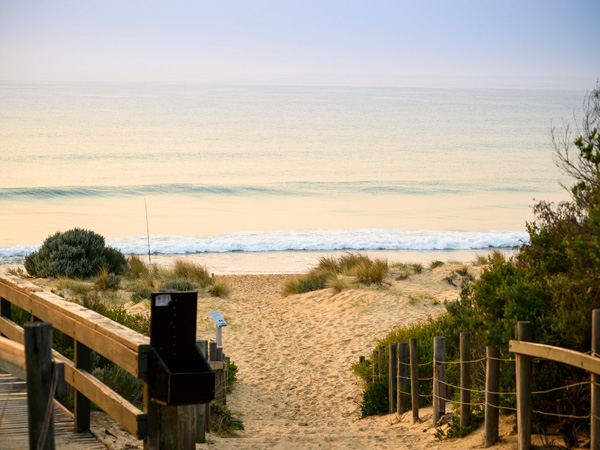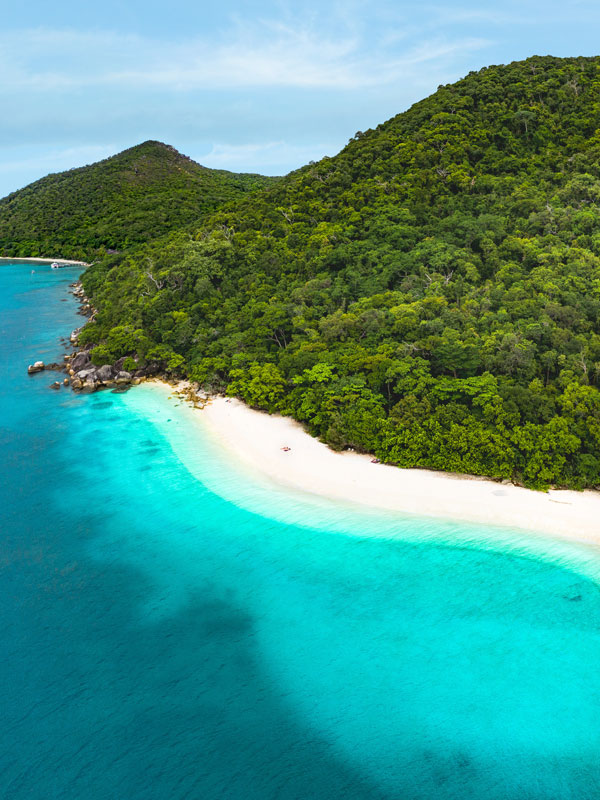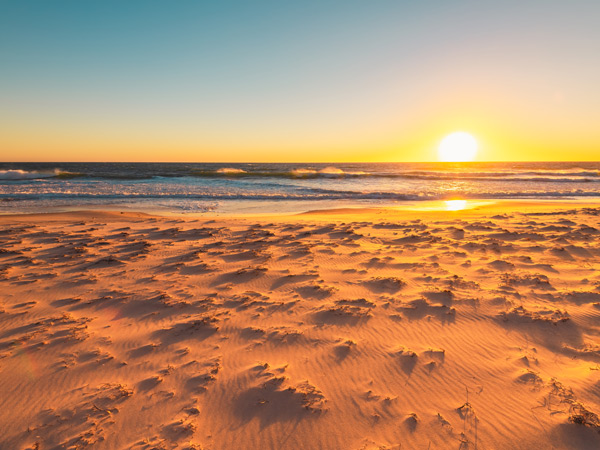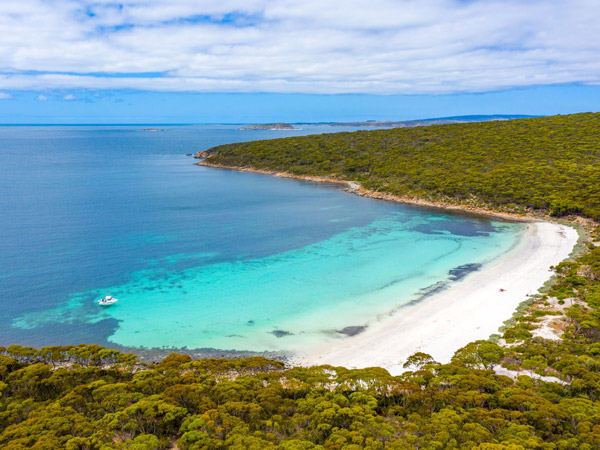11 December 2024
![]() 16 mins Read
16 mins Read

You can’t get more fun than surf, sand and sun. With more than 25,000 kilometres of coastline on offer, there’s no shortage of places to enjoy Australia at its best. But some beaches are wilder than others, plenty are inaccessible, and at this time of year a fair few are too darn overpopulated.
Here’s our exclusive list of Australia’s best secret beaches by state – just don’t tell anyone, will you?
It’s in a remote coastal valley in the Royal National Park, 40 kilometres south of Sydney. Best access is via the Princes Highway, south of Loftus, or via McKell Avenue at Waterfall.

Garie Beach is a great spot for hiking. (Image: Nick Cubbin/DPE)
Garie is supposedly an Aboriginal word for sleepy, and on most days, especially during the week, it lives up to its name. It’s a great spot for hiking and is terrific for a surf. Come winter, the whales are out to play up and down this part of the coast, making Garie a perfect place from which to spot them. Don’t forget the binoculars!

Wriggle your toes in the salty sand at Garie Beach. (Image: Adam Krowtiz)
Secluded, calm and great for families, Maitland Bay Beach is in Bouddi National Park, 20 kilometres southeast of Gosford. It’s a 20-minute walk from the Maitland Bay information centre on Maitland Bay Drive, downhill through a eucalypt forest.

Maitland Bay is nestled within a eucalypt forest. (Image: Nick Cubbin/DPE)
Chill out on the sand and enjoy a picnic – but conserve a bit of energy because it’s a steep slog on the way back up (If it took you 20 minutes on the way in, allow about 40 to get back out.)

Lay your picnic blanket on the sand at Maitland Bay. (Image: John Yurasek/DPE)
Alternatively, if you’re feeling fit, you can head on to Putty Beach via Gerrin Point lookout and arrive back at your car along the Bulimah Spur Track. The circuit is six kilometres long and will take about two hours and 15 minutes to walk if you don’t stop to take in the beautiful scenery. The nearest campgrounds are also at Putty Beach.

Nature meets serenity at Maitland Bay. (Image: Destination NSW)
The bushwalking here is half the fun. Be sure to take pause at Maitland Bay beach, however, because it truly is a sensational spot. At low tide, you can see the wreck of the paddle steamer Maitland, which ran onto the rocks in 1898. Also great for snorkelling!
Located in the Ku-ring-gai Chase National Park, the remote Resolute Beach is a 45-minute drive north of the Sydney CBD.
Combine your love of adventure with your desire to get away from it all at Resolute Beach. Accessible via the steep Resolute Track (starting at the Resolute Picnic Area), while you might arrive at this secret beach panting, you’ll soon be happy you’ve made the effort.
The small beach is lined with dense bushland, with views over the emerald water of Palm Beach, and the Pittwater and Barrenjoey Headland.
On your way here, make sure to put time aside to stop at the Red Hands Cave with its red ochre Aboriginal stencil art.

Enjoy some alone time at Resolute Beach, Ku-ring-gai Chase National Park. (Image: Destination NSW)
Just south of Tweed Heads in northern NSW, near Fingal Head. Follow the walking track that leads through the Fingal Headland Reserve from the end of the Lighthouse Parade or walk north from the Surf Lifesaving Club at Kingscliff.

Walk along the fine white sand of Dreamtime Beach.
Twenty million years ago Mount Warning erupted, producing the current dramatic backdrop of black cliffs and unique formations such as the Giant’s Causeway out in the bay. Combined with stretches of fine white sand and lush green foliage, it’s pretty close to paradise.

You’ll find lush green foliage and rock formations on Dreamtime Beach.
A stone’s throw from Manly, but the only way to get there is by water. Hire a kayak at Manly Wharf – it will take you about 20 minutes to paddle to the beach. Just ask the kindly kayak keepers which way to point your nose.
There’s hardly ever anyone there on weekdays and it’s a breeding ground for little penguins. Bliss out in the sun before heading back. You’ll feel like you’ve done your exercise for the day, too.

Store Beach is a stone’s throw from Manly. (Image: Destination NSW)
The geological dream that is the Camel Rock Formation is found on Camel Rock Surf Beach, six kilometres from Bermagui on the NSW Sapphire Coast.
Taking a photo of the unusual rock, of course! It was created by underwater avalanches over 450 million years ago. The result is that today, Camel Rock looks very much like a sitting camel. In addition, the rocky headland and the rock formation known as Camel Rock are a place of significance to the local Yuin people.
To get here, you can either park up at the Camel Rock Beach car park or at Wallaga Lake Reserve, from which you can take the 1.5-kilometre walking track from Murunna Point to the beach. Once here, snorkel, swim and fish in its rock pools to your heart’s content!

Camel Rock Formation is a geological dream. (Image: Destination NSW)
Mungo Beach stretches for more than 20 kilometres on the ocean side of Myall Lakes National Park, near Bulahdelah. It’s about 235 kilometres north of Sydney via the Pacific Highway and The Lakes Way. To access the beach, you will need a 4WD.

Spend laid-back days in the incredibly beautiful Mungo Beach. (Image: Destination NSW)
If you’re into fishing and four-wheel-driving, this is the perfect place for you. Powerful rips and deep drop-offs mean this is not a beach for swimming, but the area is full of lakes to cool off in, too.

Drive a 4WD to access Mungo Beach. (Image: Destination NSW)
You’ll find the beach off Kitty Miller Rd, on the southwestern side of Phillip Island. Phillip Island is 140 kilometres southeast of Melbourne (a 90-minute drive).
This secluded cove at the base of an extinct volcano not only has great surf, but it boasts that windswept and interesting, rugged appeal you look for in a Victorian beach (well, more northerly Australian dwellers might, anyway).

Head to Kitty Miller Bay for an unpretentious beach retreat.
Strong rips and the odd shark sighting mean surfers should take care, and swimmers should look elsewhere for a dip. Go beachcombing instead. Also, keep an eye out for the shipwrecked remains of the SS Speke at low tide.

Spot SS Speke at low tide.
Golden Beach is near Sale, 252 kilometres from Melbourne, and is just one of the delightful spots along Ninety Mile Beach – which is, of course, 90 miles (145 kilometres) of golden sand and rolling surf that stretches almost the entire length of Gippsland from Port Albert, near Yarram, north to Lakes Entrance.

Venture a little further to the glowing sands of Golden Beach.
You could find a spot to yourself anywhere along Ninety Mile Beach, but we rate Golden Beach for its great ocean fishing, surfing and wildlife. Be prepared to see heaps of kangaroos, native birds and even emus and echidnas – the reputed recluses of the animal kingdom – from the coastal tracks around here.

Keep your eyes peeled for native birds.
About seven kilometres south of Noosa, along David Low Way. It abuts Noosa National Park on the Sunshine Coast, so it’s a pristine environment well worth exploring.
With 15 kilometres of sand stretching all the way down to Peregian Beach, there’s always somewhere to get away from the madding crowds. It’s one of those quintessentially Australian beaches that overseas guests go all open-mouthed about because it looks like it’s endless. It’s also got great surf and is dog friendly, and at the right time of year, you’re bound to spot a few dolphins and whales.

Sunshine Beach is lapped by shimmering turquoise water. (Image: Tourism and Events Queensland; Reuben Nutt)
Nudey Beach is located on Fitzroy Island on the Great Barrier Reef, 45 minutes from Cairns by boat.

Nudey Beach is accessible from Cairns by boat. (Image: Tourism Tropical North Queensland)
What beats a secret beach? A secret beach on a tropical island, of course. Nudey Beach – so named because of its ‘clothes optional’ past – is a fantastic option if you want to explore off the mainland of Tropical North Queensland.
Complete with sand so white it squeaks, turquoise waters and a lack of crowds, it’s no wonder that it was voted one of Australia’s best beaches. Need more time here? Fitzroy Island Resort has a range of options for overnighters, from camping to 4.5-star accommodation.

The crystalline waters at Nudey Beach are perfect for a dip. (Image: Tourism Tropical North Queensland)
Agnes Water is Queensland’s northernmost surf beach, about 485 kilometres north of Brisbane and halfway between Bundaberg and Gladstone in Central Queensland. While it’s no secret to locals, many out-of-towners have no idea this region is sitting here just waiting to be explored.
What’s not to love about a pristine beach fringed by casuarinas and a ‘town’ (comprising a supermarket, couple of cafes, bakery, pharmacy, petrol station and not much else) that oozes laid-back charm?
Apart from Agnes Water’s main beach, there are loads of beaches nearby with hardly a soul on them. Because many are in the national park and only accessible by 4WD, you may find the only footprints on the sand are yours. It also makes a great starting point for a Great Barrier Reef visit and is great for diving, fishing and sailing.

Bask in the laid-back charm of Agnes Water Beach. (Image: Tourism and Events Queensland)
Maslin Beach is on the Fleurieu Peninsula, about an hour’s drive from Adelaide, in South Australia.

Picture golden sunsets on Maslin Beach.
In 1975 the southern section of the beach was declared Australia’s first official nude beach, but there’s plenty of room left over if you prefer swimming in Speedos.
Grab a snorkel and check out the leafy sea dragons (an actual creature, not a euphemism) or take a walk along the picturesque cliffs that flank the beach. You get a great view of the sunset from up there. Once you’ve had your fill of sun and sand, you can head off to sample what the nearby McLaren Vale wineries have to offer.

Soak up the scenic coast at Maslin Beach. (Image: Kristy Billing @gypsyandherwild)
It’s part of Lincoln National Park, 50 kilometres south of Port Lincoln and 650 kilometres south-west of Adelaide. Access to Memory Cove Wilderness Area is 4WD-only.

Spend the day frolicking in the blue waters of Memory Cove. (Image: Brad Griffin Photography)
The five campsites here are right on the beach, the scenery is seriously stunning, the fishing excellent, and with no more than 15 vehicles allowed in at any one time, it’s never going to be crowded.

Breathtaking views of Memory Cove from above. (Image: SA Tourism Commission)
This is truly one of the most elite experiences you can have in Australia but without the five-star prices.

Seek solitude in the uncrowded Memory Cove. (Image: Brad Griffin Photography)
Within Freycinet National Park, Friendly Beaches are 20 kilometres south of Bicheno on Coles Bay Road.

Friendly Beaches are hidden away from the crowds. (Image: Kathryn Leahy)
Freycinet is Tassie’s most popular coastal park, and the famous Wineglass Bay can get positively overrun (by Tasmanian standards) during summer holidays. Not so for Friendly Beaches, with their squeaky white silicone sand, crystal clear water and views that stretch forever.

Stroll along the long stretch of fine white sand and turquoise blue waters at Friendly Beaches. (Image: Stu Gibson)
With the pelican-covered Saltwater Lagoon at one end and Freshwater Lagoon at the other, in reality, Friendly Beaches are really just one very long stretch of pristine sand stroked by an aqua ocean. Because they’re so often completely people-free, it’s a good spot to try your hand (and the rest of your body) at skinny-dipping.

Friendly Beaches are completely people-free. (Image: Tourism Tasmania; Kathryn Leahy)
Just be careful of rips, because these are ocean beaches and at the mercy of strong tidal currents. That could get embarrassing for both you and the rescue party.

The waves gently ripple on the rocks. (Image: Kathryn Leahy)
This beautiful beachside camping spot is part of the Coal Mines Historic Site on the northeastern shore of the Tasman Peninsula, not far from Saltwater River, a 25-minute drive from Port Arthur.
Leave behind the crowds of Port Arthur and wander freely through the evocative ruins of Saltwater River Convict Station with its dingy underground cells – and a waterfront view to die for. The beach is fringed by limestone rocks that have been sculpted by the wind, and there are ample opportunities for wildlife, wildflowers and bird spotting.

Lime Bay is perfect for beachside camping.
Six kilometres west of Strahan on Tasmania’s wild – and often wet – west coast.

Ocean Beach is off the wild west coast of Tasmania. (Image: Jason Charles Hill)
This 40-kilometre stretch of coast is Tasmania’s longest beach, with nothing but rolling waves and fresh air between you and the east coast of South America. Go horse riding along the beach, sandboarding on the dunes, or simply watch the sun sink into the sea at the edge of the world.
Sure, it might not be the best beach for swimming and sunbaking (you shouldn’t be doing the latter anyway!), but it is certainly one of the most beautiful and isolated beaches in the world.

You’ll feel like you’re on the edge of the world at Ocean Beach. (Image: Jason Charles Hill)
Taroona is a mere 15-minute drive south of Hobart, via Sandy Bay Road.
A great beach for rock hopping, the water is perfect for kids and there is a playground in the park nearby. It’s the ultimate spot to view the Sydney to Hobart yacht race when the participants come around Storm Bay and into the Derwent River.
You’ll find a wealth of shells and marine molluscs (anecdotally, Taroona is the local Aboriginal word for chiton, a type of mollusc). You’ll also see all sorts of birds such as cormorants, terns, gulls, herons and eagles.

Go rock hopping at Taroona Beach.
Garig Gunak Barlu National Park is around 570 kilometres (by road) northeast of Darwin and is accessible only by 4WD. It’s impassable during the wet season, November-April. Bring all your own food, unless you count on catching some fish (which practically jump onto your hook!).

Get whisked off to Seven Spirit Bay Cobourg Peninsula. (Image: Tourism NT; Tourism Australia)
It’s a place of pristine beaches, carpeted in seashells, where turtles come up to lay their eggs and the world’s largest remaining herd of banteng (wild cattle) roam in the monsoon forests behind the high-tide mark. Even better, only 20 permits to enter the park are issued at any one time, so you know you’ve got the place pretty much to yourself. Forget about swimming though: this is saltwater crocodile country.

Set up camp in your 4WD at Cobourg Peninsula. (Image: Tourism NT; Tourism Australia)
Bennion Beach is in the northern suburbs of Perth, about a half-hour drive from the centre of the city.
You can stay in the heart of Perth and still savour the secluded nature of this incredible sheltered white-sand beach strewn with giant clusters of limestone. Most of the summer crowds hang at neighbouring Trigg Beach, so you can snorkel and explore the surrounding reef in peace.
People from the eastern states always get a kick out of a WA beach sunset, so stick around and watch the colours stain the sky.

Set foot on the secluded shores of Bennion Beach.
Point Ann is in the western section of Fitzgerald River National Park, 180 kilometres northeast of Albany. The best access is via Bremer Bay; from the east, the best access is via Hopetoun or the Hamersley Drive from the South Coast Highway.
It’s one of just two places in Australia (the other is Head of Bight in SA) where southern right whales come to calve in large numbers. There are two whale-watching platforms and the best time to go to make use of it is June through to October.

Watch out for whales at Point Ann, WA.
Cape Le Grand National Park, 50 kilometres southeast of Esperance by sealed road.

Endless blues ripple across Lucky Bay. (Image: Tourism Western Australia)
Breathtaking scenery, beachside camping and a fantastic 15-kilometre coastal walking trail from Le Grand Beach to Rossiter Bay along the edge of Cape Le Grand. You’ll find Lucky Bay at about the halfway point.

Spot kangaroos happily hopping on the beach. (Image: Tourism Western Australia)
You’ll also find southern grey kangaroos sunning themselves on the beach. If there are too many fishermen here for your liking, head around the point to Thistle Cove, where you’re unlikely to find a soul.

Go for a dip in the pristine waters of Lucky Bay.
Excellent article on secret beaches in Oz.
We really are the lucky country.
Sand, sea, blue skies above.
Nature at its best. Dolphins, whales, birds to enjoy.
Forests, trees, in this far land.
Escape to paradise.